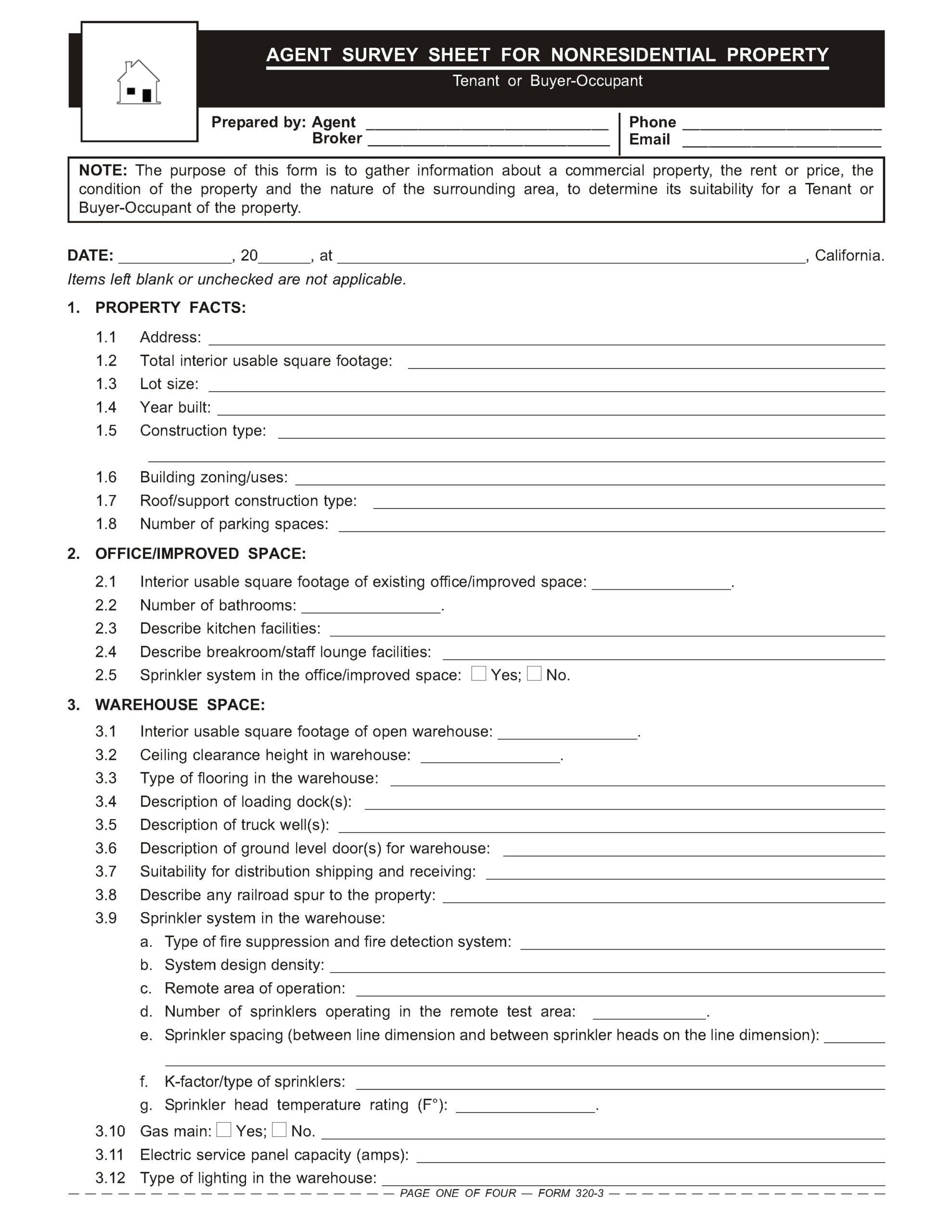This form is used by an agent when representing a prospective buyer or tenant of commercial property, to provide a checklist for gathering preliminary information on the suitability of a property for acquisition or leasing.
Analytical tools for agents of buyers and tenants
An agent of a buyer or tenant is duty-bound to check out available properties to purchase or lease since they are employed to located property most likely to satisfy their client’s needs. The agency rule is “know what you are peddling so not to mislead the buyer or tenant.” [Jue v. Smiser (1994) 23 CA4th 312]
When a property the agent locates appeals to the client, the agent needs to look into the property’s ownership and its physical and title conditions to collect information for review with their client before the client can intelligently decide the optimal price or rent they are willing to pay.
To consider the depth of this agent duty to consumers of real estate services, be aware that buyers and tenants over the past few decades have become fully dependent on agents for their purchase or leasing real estate. Rarely do participants in property transactions directly contact other principals themselves — relics of the past. Very few direct contacts between owners and users occur. Thus, agents have become, essentially, the gatekeepers for a consumer’s entry into a real estate transaction.
Part of properly representing a buyer or tenant is to note that a client’s nexus to determining a property’s usefulness and worth for their purposes is solely their agent who gathers information the client needs to make an informed decision about their purchase or lease.
An agent representing a client seeking property for purchase or lease gathers critical transaction information by interviewing the seller or seller’s agent about the property’s condition, rent or price, conditions in the surrounding area and overall suitability for the client’s purposes.
An agent scouting a commercial building for a buyer or tenant uses the Agent Survey Sheet for Commercial Property as a checklist to gather and document information for determining the suitability of a commercial property for their client. [See RPI Form 320-3]
Information to gather for commercial property tenants or buyers
The information a commercial tenant or buyer’s agent may consider collecting to help their client make an informed decision includes information about the:
- property [See RPI Form 320-3 §1];
- office and improved space [See RPI Form 320-3 §2];
- warehouse space [See RPI Form 320-3 §3];
- lease term [See RPI Form 320-3 §4];
- sales terms [See RPI Form 320-3 §5];
- location/neighborhood [See RPI Form 320-3 §6];
- property investigation [See RPI Form 320-3 §7];
- operating expenses [See RPI Form 320-3 §8]; and
- owner’s agent. [See RPI Form 320-3 §9]
Property information includes the:
- address;
- total interior usable square footage;
- lot size;
- year built;
- construction type;
- building zoning and uses;
- roof/support construction type; and
- number of parking spaces. [See RPI Form 320-3 §§1.1 through 1.8]
Office/improved space information includes the:
- interior usable square footage of existing office/improved space;
- number of bathrooms;
- kitchen facilities description;
- breakroom/staff lounge facility description; and
- whether there is a sprinkler system in the office/improved space. [See RPI Form 320-3 §§2.1 through 2.5]
Warehouse space information includes the:
- interior usable square footage of the open warehouse;
- ceiling clearance height in the warehouse;
- type of flooring in the warehouse;
- description of loading docks;
- description of truck wells;
- description of ground level doors for the warehouse;
- suitability for the distribution of shipping and receiving;
- nearby railroads;
- sprinkler system in the warehouse;
- gas main;
- electric service panel capacity; and
- type of lighting in the warehouse. [See RPI Form 320-3 §§3.1 through 3.12]
Lease term information includes:
- the monthly asking rent;
- any tenant move-in incentives offered;
- planned incremental rent increases;
- the term of the lease;
- security deposit;
- required upfront prepaid rent;
- any option to extend the lease;
- any option to buy the property;
- any right of first refusal;
- maintenance costs paid by the owner;
- utility expenses paid by the landlord;
- whether the owner or tenant will pay for property taxes and insurance premiums;
- monthly common area maintenance (CAM) charges for the space;
- whether the tenant or owner pays tenant improvements (TIs);
- whether the tenant or owner pays repairs for vandalism or earthquake damage; and
- the date the tenant may take possession of the property. [See RPI Form 320-3 §§4.1 through 4.17]
Sales term information includes:
- whether the property is offered for sale;
- the listing price;
- the sale price expected and FMV;
- the price the owner paid for the property;
- what informed the listing price;
- the minimum down payment expected;
- existing financing; and
- new financing. [See RPI Form 320-3 §§5.1 through 5.8]
Location/neighborhood information includes:
- a description of the surrounding area;
- the volume of foot traffic the location receives;
- the distance to the freeway;
- the closest bus route;
- distance to the nearest post office;
- distance to the nearest bank;
- distance to a police station;
- distance to a fire station;
- distance to local amenities, such as restaurants and shopping;
- whether local food truck service is available;
- distance to the regional airport;
- problems with vandalism or crime reported in the area;
- known prior earthquake damage in the area, earthquake faults or seismic hazards; and
- problems with noise nuisance in the area. [See RPI Form 320-3 §§6.1 through 6.14]
Property investigation information includes:
- available printed information on the property the owner’s agent can provide;
- title information;
- whether the mortgage lender will subordinate to the tenant’s lease;
- the reason the owner is leasing or selling the property;
- whether there were any prior offers to rent;
- whether there were any prior offers to buy;
- whether subleasing is allowed;
- personal property included;
- whether the property is in compliance with city ordinances;
- certifications and retrofitting required;
- the existing internet connections and phone lines;
- energy efficient improvements;
- the energy performance score;
- limitations for placing a sign/logo on the property;
- whether landscaping can be modified;
- other properties owned by the owner;
- the owner’s age;
- the type of business operations of other tenants in the building;
- the length of time other tenants have occupied the property;
- contact information of other tenants;
- whether the property has been maintained;
- the extent of improvement obsolescence;
- security measures installed at the property;
- the local vacant property absorption rate; and
- the property’s unique benefits. [See RPI Form 320-3 §§7.1 through 7.25]
Operating expenses information includes:
- property taxes;
- office expenses/supplies;
- advertising;
- electricity;
- gas;
- water/sewer;
- trash;
- insurance;
- management fees;
- lawn/gardening;
- janitorial;
- maintenance;
- repairs and replacements;
- cable/phone;
- accounting/legal fees;
- security system;
- HVAC maintenance; and
- roof maintenance. [See RPI Form 320-3 §§8.1 through 8.18]
The owner’s agent information includes:
- the agent’s name and license number;
- the broker’s name and license number;
- the agent’s phone number; and
- the agent’s email. [See RPI Form 320-3 §§9.1 through 9.3]
Armed with a complete and detailed profile of the owner, the neighborhood and the condition of the property selected for the agent’s review with their buyer or tenant, the collected data and information contributes to a decision on the suitability of a property and what price and terms to offer for the purchase or lease of the property.
Form navigation page published 04-2023.
Form last revised 2013.
Form-of-the-Week: Open House Interview Sheet, and the Agent Survey Sheet for Commercial Property — Forms 320-2 and 320-3
Article: How new agents gain trust from commercial clients
Article: How to evaluate the location of a new commercial property
Blog: Industrial real estate set to normalize
Blog: California’s commercial property shortage is making investors desperate
Blog: SoCal commercial real estate results are in
Blog: 2022 commercial market to be led by industrial and conversions
Blog: Investors eye future interest rates
Blog: Warehousing costs skyrocket as pandemic shortages drag on
FARM: Commercial for-lease flyer
FARM: Your commercial property needs a fresh strategy
FARM: Solicitation for owners of commercial property
FARM: Commercial tenant relocation
FARM: Commercial Postcard
FARM: Commercial Flyer














